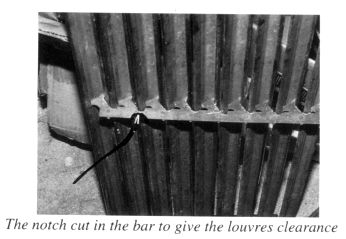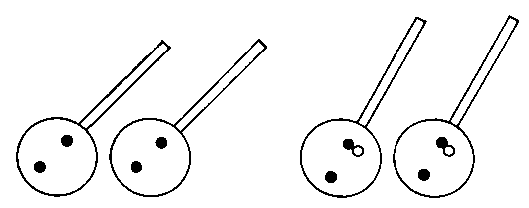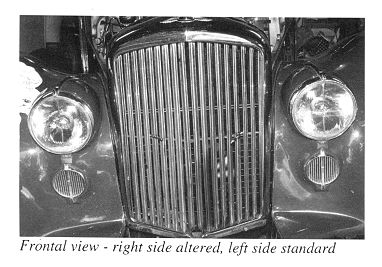From RROCA-info
Increasing Air Intake on Early Post-War Cars
By Tony Ward (NSW), July 1999
This article details an experiment which I recently carried out to improve the cooling capability on my Mark VI; opening up the radiator grill louvres.
Earlier pre-war cars had manual control of the louvres so that they could be positioned anywhere from fully closed to fully open. Calorstat units were fitted in the thirties to most models to perform this operation automatically according to engine temperature. It was an ideal setup for all weather conditions provided the cooling system was in good order, and even if it wasn't, it acted to counteract overheating!
Post-war design brought us thermostats for quick engine warm up and constant desired operating temperature in all but extreme atmospheric heat. However, post-war design also brought us fixed radiator louvres which tend to restrict airflow onto the radiator matrix.
If you look at any Rolls-Royce or Bentley after the R Type (and even some late delivery R Types), you will notice that the louvres are much more open and do not present resistance to air flow.
By measuring the gap between the louvres of my Mark VI with varying size twist drill shanks, I found that the average gap was 5/16". I have opened this gap to 1/2", and virtually doubled the air entry space and reduced the angle of air resistance in the process.
Having recorded engine temperatures over a fixed route across the Hawkesbury to Mangrove Mountain at maximum permitted road speeds, and noted ambient temperatures, I took the car with altered louvres over the same route and I think I can confidently claim that the alteration is worth 4 - 5 degrees C on the gauge on a hot day. Moreover, recovery after a long climb seems quicker than it used to be, i.e. returning to a more normal operating temperature.
In cold weather, your engine should not run below normal operating temperature because the thermostat will take care of the ambient situation.
Carrying out the alteration is well within the capability of the average home mechanic.
Here's how it's done:
- Remove the bonnet.
- Drop the front bumper bar, disconnecting any lamp wires, and unbolting the centre stone guard section from the mudguards.
- Remove all the bolts which bind the front curve of the mudguards to the chrome grill and radiator steel cradle. The bolts back about half way to the bulkhead should be loosened to enable the mudguard front sections to be opened out to allow the grill to be removed, after lower edge bracket bolts have been extracted.
- Remove the stone guard and the top and bottom nuts and bolts which hold the louvres in the shell.
Now for the easy part:
- The louvres are held top and bottom by two rows of 1/8" pop rivets.
- With a 1/8" drill, carefully drill out the front row of rivets top and bottom.
- Using the rear rivets as a pivot, open up the angle of separation to 1/2" using a drill shank as a spacer.
- I found that the centre holding bar of the louvres needed a small notch cut into it where every louvre touched hard against it in the new open position. (Figure 1). Use a triangular file or the side of a drill bit (hardly kosher!). This notch relieved any tension on the louvre because of the new top and bottom positions.
- With the louvre held in its new position, drill a new hole through the frame and base (and top) of each louvre so that you can drill and pop rivet and thus re-position it. (Figure 2). Use 1/8" drill and rivets.
As you can see by the frontal photo, where the righthand side has been opened up, but not the left, there is very little loss of aesthetic appeal. There is a 5/16" drill in the unaltered half and 1/2" in the opened sections. When one stands off and looks at the radiator grille, most people are unaware that there has been an alteration.
The Company brought out a sheet detailing a similar alteration, but I have been unable to locate a copy.
This alteration should not be carried out to try and ease an overheating problem which has its source elsewhere in the engine and cooling system. Rather, it is intended to assist the cooling capacity of cars operating in hot summer conditions.



